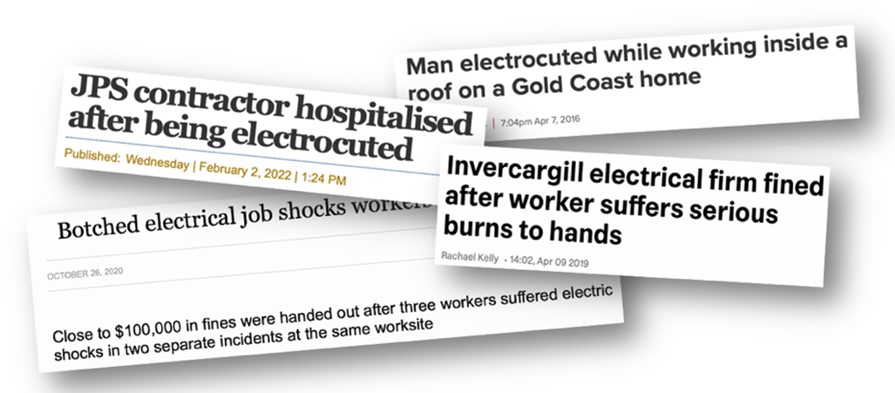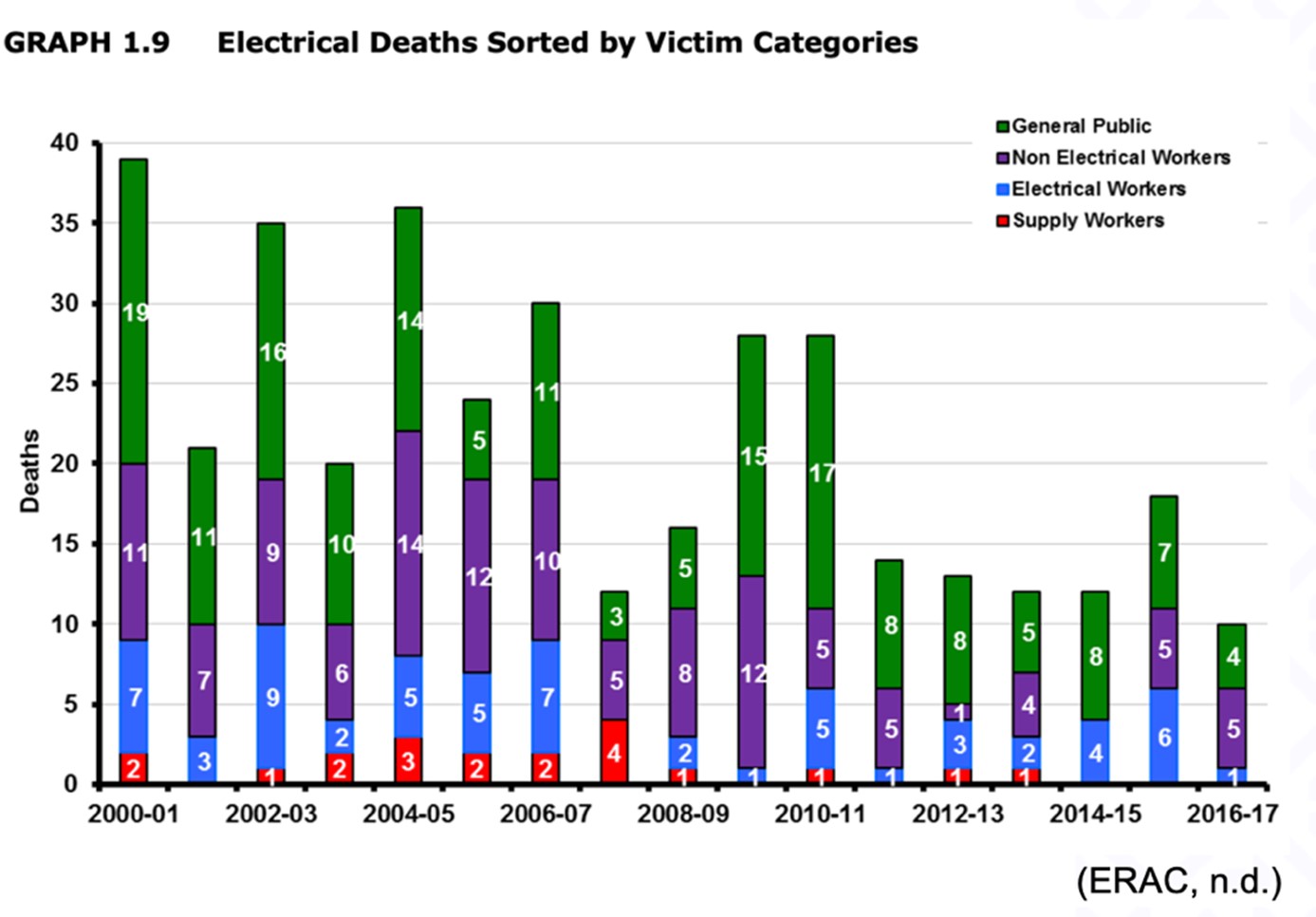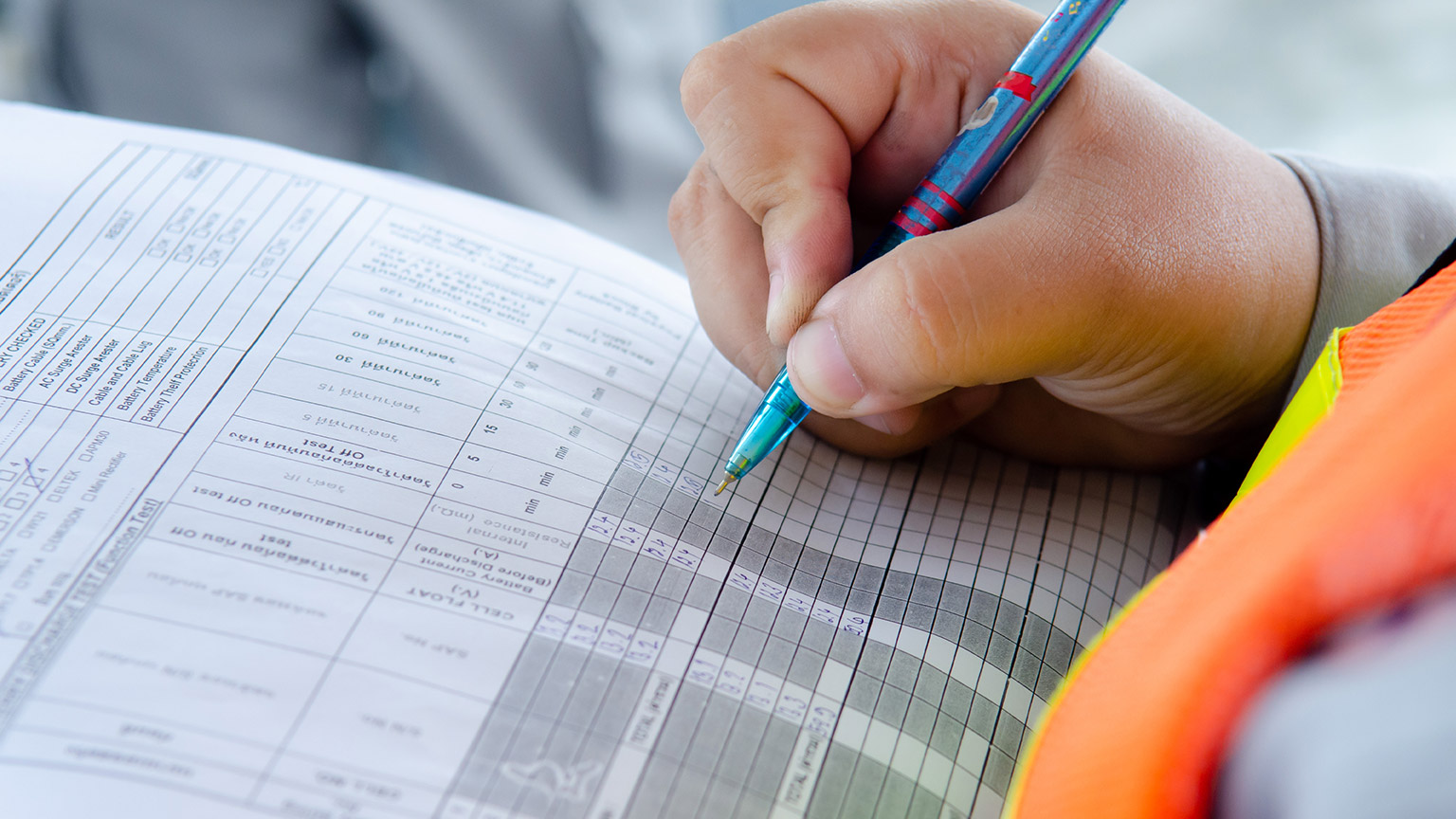In this topic we are going to look at the legislation and governing bodies that ensure the electrical supply in Aotearoa New Zealand is managed and supplied as safely as possible. You will need to be familiar with the basic purpose of each piece of legislation, and some of the basic conditions that will affect you as you begin your apprenticeship journey. You do not need to know all of the details – you will learn more about the laws as you progress into Level 4 and onwards.
What we’re covering:
- Legal terminology
- Acts, Regulations, Standards and Codes
- Governing Bodies
Legal Terminology
Have you ever wondered what the difference is between words such as ‘Act’ and ‘Legislation’? We see and hear these words nearly every day in the media, but what do they actually mean? Test your knowledge in the drag-and-drop activity below. All you need to do is use your mouse to move each explanation next to the word or phrase that they match.
If you come across any other legal terms that you are not sure of, you can check this glossary provided by the Ministry of Justice: Glossary | New Zealand Ministry of Justice
The following infographic shows the hierarchy of the legal terms, with Acts of Parliament being at the top.
Electrical Industry Acts
In this programme we are only going to look at three main Acts, although there are others that you will need to be aware of as you continue your career pathway towards being a registered electrician. The three that we will be covering are:
- The Electricity Act (1992)
- The Electricity Industry Act (2010)
- Health and Safety at Work Act 2015
The Electricity Act (1992)
| Purpose: |
|
| Enforced/administered by: |
|
| Key Points: |
|
You can find the Act here: Electricity Act 1992 No 122 (as at 24 August 2023), Public Act 1A Purposes – New Zealand Legislation
Useful sections include:
- Part 9 – Restrictions Electricity Act 1992 No 122 (as at 24 August 2023), Public Act 74 Restrictions on doing or assisting with prescribed electrical work – New Zealand Legislation
- Part 9 – Exemptions Electricity Act 1992 No 122 (as at 24 August 2023), Public Act 76 Exemption for work done under supervision – New Zealand Legislation
- Part 14 – Offenses Electricity Act 1992 No 122 (as at 24 August 2023), Public Act 161 Unlicensed or unregistered person must not claim to be licensed or registered – New Zealand Legislation
Parts of this Act have been replaced by the next Act that we are going to touch on.
The Electricity Industry Act (2010)
| Purpose: |
|
| Enforced/administered by: |
|
| Key Points: |
|
You can find the Act here: Electricity Industry Act 2010 No 116 (as at 24 August 2023), Public Act Contents – New Zealand Legislation
Health and Safety at Work Act 2015
This is a really important Act for all New Zealanders who work. It’s also a very large and detailed Act, so we are going to cover it in the next section.
Electrical Industry Regulations
Regulations for the electricity industry are created under Part 5 of the Electricity Industry Act 2010. The most important regulation for you to be aware of is The Electrical (Safety) Regulations 2010.
| Purpose: |
|
| Enforced/administered by: |
|
| Key Points: |
|
You can find the Regulations here: Electricity (Safety) Regulations 2010 (SR 2010/36) (as at 18 July 2022) Contents – New Zealand Legislation
Useful sections include:
- Part 1 - Electrically Safe and Unsafe Electricity (Safety) Regulations 2010 (SR 2010/36) (as at 18 July 2022) 5 Meanings of electrically safe and electrically unsafe – New Zealand Legislation
- Part 1 – Low risk and high risk work Electricity (Safety) Regulations 2010 (SR 2010/36) (as at 18 July 2022) 6A Meaning of low-risk, high-risk, and general prescribed electrical work – New Zealand Legislation
- Part 1 – Penalties Electricity (Safety) Regulations 2010 (SR 2010/36) (as at 18 July 2022) Penalty levels – New Zealand Legislation
- Part 2 – General Safety Requirements. (You should read all of the pages associated with this)
We’re going to look a little more closely at the Regulations in the next section.
Electrical Industry Standards
Standards are informed by Acts and Regulations and provide specific detail about working in the industry that are not practical to be put in an Act or a Regulation. There are a lot of standards that apply to the electrical industry, but the main ones we will focus on in this programme are:
- AS/NZS: 3000/2007
- AS/NZS: 3760/2010
- AS/NZS: 4836/2011
We will be referring to these standards frequently across all 5 modules of this programme.
Electrical Industry Codes
Codes of practice for the electrical industry in Aotearoa New Zealand are informed by the Electricity Safety Regulations 2010. There are multiple codes for different context. We will not be covering all of them in this programme.
| Purpose: |
|
| Enforced/administered by: |
|
| Key Points: |
|
We’ll refer to several of these codes throughout the programme content.
There are a number of government departments and industry run organizations whose job it is to ensure that the electricity industry in Aotearoa New Zealand is safe and legal.
Ministry of Business, Innovation and Employment (MBIE)
You can read about the role they play in the construction and energy industries here: Home | Ministry of Business, Innovation & Employment (mbie.govt.nz)
As we covered earlier this ministry is responsible for some of the Acts and Regulations that control the electrical industry.
Worksafe NZ
WorkSafe is the primary health and safety regulator in New Zealand. We will be covering their role in the electrical industry in and upcoming section. You can read about WorkSafe here: Home | WorkSafe
ERAC – Electrical Regulatory Authorities Council
The prupose of ERAC is to provide Australia and New Zealand a uniform regulatory environment for electrical activities, for the purpose of achieving acceptable levels of electrical safety, supply quality and energy use efficiency. It’s made up of a mix of representatives from Australia and New Zealand.
You can find out more here: ERAC – Electrical Regulatory Authorities Council
EWRB – Electrical Worker’s Registration Board
The purpose of this organisation is to ensure competency of all electricians. To work as an electrician in New Zealand, you must be licensed by this body.
You can find out more here: Electrical Workers Registration Board (ewrb.govt.nz)

What we're covering:
- Health and Safety at Work Act (HSWA)
- Be a Safe Guy and Puataunofo
The Health and Safety at Work Act (HSWA) came into effect in 2016. It is the key work health and safety law in New Zealand and covers nearly all work and workplaces.

Its aim is to protect workers and other people against harm to their health, safety and wellbeing by eliminating or minimising risks at work. People are the most important asset in any business or organisation, and ensuring their health and safety is critical.
He aha te mea nui o te ao? He tāngata. He tāngata. He tāngata. What is the greatest treasure in the world? It is people. It is people. It is people.
The complete Health and Safety at Work Act can be found here.
However, you may find the HSWA guides here and here easier to understand for later reference.
Watch the video explaining the HSWA. Fill in the missing terms as you proceed. This is an excellent summary of the Act for you to refer back to.
Click on the links below introducing the ‘Be A Safe Guy’ and the Puataunofo campaigns. We’ve looked at these already, but this is a good time to refresh your memory.
Puataunofo 'Come Home Safely' programme
However you say it, be a safe guy - WorkSafe New Zealand
Activity
According to the Health and Safety at Work Act (2015), employers or officers in a workplace must take some key steps. Which three steps does this include?
What we're covering:
- The Electrical (Safety) Regulations 2010
- AS/NZS 4836/2011
- Electrical fatalities in NZ and Australia
You should now have a greater understanding of the HSWA and its role in protecting you and your workmates against harm to your health, safety and wellbeing by eliminating or minimising risks at work.
Other safety legislation particular to the electricity industry includes:
The Electrical (Safety) Regulations 2010 promote the health and safety of members of the public, and promote the prevention of damage to property, around the supply and use of electricity in New Zealand. They gather together and state the generic rules and requirements about electrical safety, and what is deemed to be electrically safe and electrically unsafe. The Regulations are intended to help businesses understand how to manage particular electrical hazards.
Read more about the Regulations on the WorkSafe site here.
The complete Electricity (Safety) Regulations 2010 document can be found here.
Activity
Which item in the Regulations would you refer to if you wanted more information about:
The table below contains summaries of some sections from the Electricity (Safety) Regulations 2010.
S/NZS 4836:2011 is further legislation dealing with safety – in particular “safe working on or near low-voltage electrical installations and equipment”.
The Standard covers a wide range of safety issues that electrical workers face every day, providing a minimum set of procedures, safety requirements and recommendations to manage the hazards associated with electricity, specifically arc blast, arc flash, electric shock and electrocution.
Section 5.1.1 of the standard AS/NZS 4836:2011 describes the safe use of ladders and stepladders.
Study the chart which shows electrical fatalities from Australia and New Zealand between 2000 and 2017.

Download this Worksheet to your device and complete the questions. Bring it to class to compare with your classmates’ answers. You can also ask your tutor for feedback.
What we're covering:
- The Wiring Rules Part One
- The Wiring Rules Part Two
- Codes of Practice
AS/NZS 3000:2018, Electrical installations – more commonly known as the Wiring Rules, are the technical rules that help electricians design, construct and verify electrical installations.
These rules are intended to protect people, livestock, and property from electric shock, fire and physical injury hazards that may arise from an electrical installation that is used with reasonable care and with due regard to the intended purpose of the electrical installation.
AS/NZS 3000 sets out the requirements for electricians to install the correct piece of equipment for the purpose intended. All electrical installations are tested and verified to be safe after they are constructed, altered, modified, or repaired. You will find specific information on testing in section 8 of AS/NZS 3000.
The Wiring Rules consist of two separate parts: Part 1 is what you are going to achieve and Part 2 is how you are going to achieve it.
Part One
Outlines the scope, application and fundamental safety principles required for a safe electrical installation, ensuring the protection of people and property. The principles are mandatory, so you must comply with them!
The definitions in Section 1.4 are really important and helpful to understanding electrical terms and the standard itself.
Section 1.5 provides 14 fundamental safety requirements intended to protect people and property against harm and damage.
Part Two
Outlines the requirements and methods electrical workers must follow to ensure compliance with Part 1 of the standard. It expands on the ‘high level’ performance outcomes of Part 1 and talks about how to achieve them in real life.
Locating passages in the AS/NZS 3000
The AS/NZS 3000 document has contents pages which present information in the following sequence:
- Contents: The Contents are broken down into sections 1 to 8. Each section has subject titles and is further broken down into subsections with subject and page numbers.
- Appendices: A list of appendices in the standard.
- Tables: A list of tables in the standard.
- Figures: A list of figures in the standard.
The standard also has a very good index at the end which can be useful for locating a subject you have a term or name for. You need to know which is the most effective way to find what you are looking for - depending on what information you are starting with.
Activity
Let’s look at an example. Assume you have been asked to define the term ‘readily accessible’. You can do this in two ways:
- Look at the contents page and find definitions. This is Section 1 clause 4. Sub-clause 1.4.2 is “Accessible, readily’.
- Look up the Index page at the end of the standard and locate ‘accessibility’ which is the first term. There you have ‘a definition of 1.4.2 which refers to the definition being present in Section 1, clause 4, sub-clause 2.
Your tutor will give you some other terms to locate.
You should read AS/NZS 3000. To become a qualified electrician, you will need to sit an exam on it. Each job you do, look at the rules that cover what you are doing that day in AS/NZS 3000. By doing this, you will slowly but surely familiarise yourself with AS/NZS 3000.
Codes of Practice
Electrical Codes of Practice (ECPs) are issued by WorkSafe under Section 36 of the Electricity Act 1992 and are used to ensure compliance with the Electricity (Safety) Regulations. They work on the principle that any installation, fitting, appliance, or other equipment must be electrically safe to provide appropriate protection for people and property.
According to the Electrical Act, the purposes of the Electrical Codes of Practice include:
- The setting or endorsing of standards or specifications concerning the design, construction, installation, importation, or manufacture of works, electrical installations, fittings, electrical appliances, or associated equipment.
- The setting of standards regarding electricity that will be supplied to, or used by, electricity retailers and consumers.
- The operation or use of works, electrical installations, fittings, electrical appliances, or associated equipment.
- The inspection or maintenance of works, electrical installations, fittings, electrical appliances, or associated equipment.
- The safety of persons or property associated with or using works, electrical installations, fittings, electrical appliances, or associated equipment.
Schedule 2 of the Electricity (Safety) Regulations, ‘cites’ the Electrical Codes of Practice which makes them officially binding.
Structure of the ECPs
As in the case of the Standards, the ECPs contain mandatory (no choice, you must do this) requirements for compliance with the Electricity (Safety) Regulations. They also include best practices (not mandatory but highly recommended for good results) when carrying out work.
Best practices are often used to ensure safety where non-electrical workers (such as homeowners or other trades) are working on or around electrical equipment and fittings. ECPs use the following terms to indicate whether the code is mandatory or not. These are:
- Shall: Indicates a statement is mandatory to achieve compliance with the ECP.
- Should: Indicates a statement is indicating good practice but is not mandatory.
- May: Indicates the existence of an option.
Activity

What we're covering:
- certification of electrical work
- risk categories
Prescribed electrical work (PEW), is categorised as being high risk, low risk, or general work and each category has its own set of inspection and certification requirements.
These two video presentations explain the key aspects of the Electrical (Safety) Regulations 2010 for prescribed electrical work.
An overview of the changes to the Electricity Safety Regulations 2010
Certifying electrical installation work
The first video describes the risk categories of prescribed electrical work (PEW), including examples of high risk, low risk, and general work, while the second video talks about the certification of electrical work and the various requirements such as Certificates of Compliance, Records of Inspection and Electrical Safety Certificates.
Activity
In your own words explain what is meant by high risk, low risk, and general work. Include examples of each. Note what type of certification is required for each level of risk.
The following may be useful to refer to:
